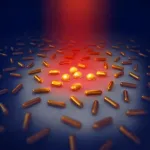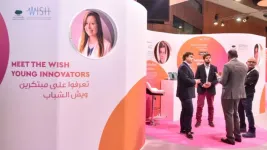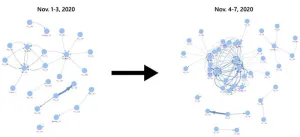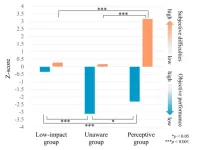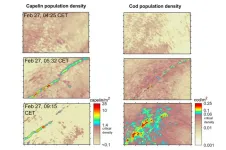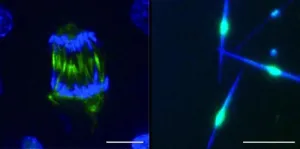(Press-News.org) In the fight against antibiotic resistance, a new technology developed at Chalmers University of Technology, in Sweden, can be of great importance when, for example, hip and knee implants are surgically inserted. By heating up small nanorods of gold with near-infrared light (NIR), the bacteria are killed, and the surface of the implant becomes sterile. The researchers are now presenting a new study that increases the understanding of how the gold rods are affected by light and how the temperature in them can be measured.
Infections can occur during surgical procedures, with the risk increasing significantly when foreign materials, such as knee prostheses, are implanted into the body. The presence of the material weakens the body's immune system and antibiotic treatments are commonly used. If infected, high doses of antibiotics are often required with long treatment times, sometimes lifelong. This entails a risk of increased antibiotic resistance, which is seen by the WHO as one of the greatest threats to human health.
Heat kills the bacteria on the implant surface
The technology developed by the researchers at Chalmers is a method in which nanometre-sized rods of gold are attached to the implant surface. When near-infrared (NIR) light hits the surface of the implant, the rods heat up and act as tiny heating elements. Because the heating elements are so small, there is a very local heating, which kills any bacteria on the surface of the implant without heating the surrounding tissue.
"The gold rods absorb the light, the electrons in the gold are set in motion, and finally the nanorods emit heat. You could say that the gold nanorods work like small frying pans that fry the bacteria to death," says Maja Uusitalo, doctoral student at Chalmers and lead author of the study, which has been published in the journal Nano Letters.
NIR light is invisible to the naked eye but has the ability to penetrate human tissue. This property allows the gold nanorods to be heated on the surface of the implant inside the body by illuminating the skin. The gold rods are sparsely distributed and cover only about ten percent of the implant's surface. This means that the material's beneficial properties, such as the ability to attach to bone, are largely retained.
"The trick is to tailor the size of the rods. If you make them a little smaller or a little bigger, they absorb light of the wrong wavelengths. We want the light that is absorbed to penetrate skin and tissue well. Because once the implant is inside the body, the light must be able to reach the surface of the prosthesis," says Martin Andersson, Professor and research leader at Chalmers.
Precise measurements for gold rod temperature
To increase the understanding of how the technology works, and how the NIR-heated gold nanorods affect both bacteria and human cells, the researchers needed to measure the temperature of the rods. Due to their tiny size, it is impossible to measure with a regular thermometer, instead the researchers used X-rays to study how the gold atoms move. The method enables precise measurement of the temperature of the gold rods and how the temperature can be regulated using the intensity of the NIR light.
" The temperature must not exceed 120 degrees Celsius, as higher temperatures cause the nanorods to lose their shape and transform into spheres. As a result, they lose their optical properties and can no longer absorb NIR light effectively, which prevents the rods from heating up” says Maja Uusitalo.
She points out that the heating is very local with low energy transfer to the surroundings. This is crucial to avoid causing any damage to the surrounding tissue.
The researchers hope that the method can be used on many different implant materials, such as titanium or different plastics.
Gold rods become antibacterial when activated
The gold nanorods themselves are completely passive on the surface before the NIR light heats them. Only then are the rods activated, becoming hot and triggering the antibacterial effect.
"We can control when the surface should be antibacterial and when it should not. When we turn off the light, the surface is no longer antibacterial and reverts to its original state. This is an advantage because many antibacterial surfaces usually have negative effects on healing," says Martin Andersson.
The goal is to eventually bring this technology into healthcare.
"We primarily believe in using NIR light for heating shortly after the implant is placed and the wound is sutured. By heating up the gold nanorods, we can eliminate any bacteria that may have settled on the prosthesis during surgery." says Martin Andersson.
All bacteria die from the heat from the gold nanorods, but even ordinary cells can be damaged during treatment.
"If a few human cells are destroyed during the NIR heating process the body quickly regenerates new ones, so the impact on healing is minimal," says Martin Andersson.
The technology with NIR-heated gold nanorods has previously been studied in cancer research, but the research group at Chalmers is the first to use the technology to create an antibacterial surface on implants with high precision and control.
More about the scientific article:
The article, Photothermal properties of solid-supported gold nanorods, was published in Nano Letters.
The researchers behind the study are active at the Division of Applied Chemistry, Department of Chemistry and Chemical Engineering and Chalmers Materials Analysis Laboratory, at Chalmers University of Technology.
The research was funded by Chalmers' Area of Advance Materials and the Knut and Alice Wallenberg Foundation through the Wallenberg Academy Fellows programme.
For more information, please contact:
Martin Andersson, Professor at the Division of Applied Chemistry, Department of Chemistry and Chemical Engineering, Chalmers University of Technology.
+46 31 772 29 66
martin.andersson@chalmers.se
Maja Uusitalo, PhD student at the Division of Applied Chemistry, Department of Chemistry and Chemical Engineering, Chalmers University of Technology.
majau@chalmers.se
The contact persons both speak English and Swedish. They are available for live and pre-recorded interviews. At Chalmers, we have podcast studios and broadcast filming equipment on site and would be able to assist a request for a television, radio or podcast interview.
More about the study
In the experiments, glass has been used as the underlying material, and the gold nanorods are bound through an electrostatic interaction. This interaction is possible because the gold rods have a positive charge, and the glass surface is negatively charged.
The gold rods in the study have been placed sparsely on the surface and make up about 11 percent of the material area.
The size of the gold nanorods is 20 by 70 nanometers and they absorb light in the NIR region around 800 nanometers.
When the gold rods absorb the light, the electrons in the outer layers of the rods are set in motion and heat is generated, a phenomenon called Surface plasmon resonance. The heat generated is very local, and the bacteria die from the heat.
To preserve the shape of the rods and maintain the material's properties, their temperature must not exceed 120 degrees Celsius. However, it's important to note that the energy of the generated heat is low, so the surrounding tissue will not be heated to the same temperature as the surface of the gold nanorods.
Illustration: Daniel Spacek, Neuron Collective, neuroncollective.com
Caption: The illustration shows how the gold nanorods heat up when illuminated with NIR light. At temperatures above 120 degrees Celsius, the gold rods begin to change shape, and their optical properties change.
END
Tiny gold radiators fry bacteria on implants
2024-10-29
ELSE PRESS RELEASES FROM THIS DATE:
WISH announces shortlist for Global Healthcare Innovation Awards
2024-10-29
29 October 2024. Doha, Qatar – The World Innovation Summit for Health (WISH), an initiative of Qatar Foundation, has shortlisted 12 innovators for two awards within the 2024 WISH Global Healthcare Innovation Competition. Selected from more than 150 applications, the 12 will showcase their groundbreaking innovations to global policymakers and healthcare leaders at this year’s summit in Doha, 13-14 November.
In addition to the chance to receive one of two investment awards of US$10,000, shortlisted innovators will have access to mentoring sessions with industry experts to learn ...
Discovery of cancer risk associations for six novel genes
2024-10-29
Discovery of cancer risk associations for six novel genes
Scientists at deCODE genetics/Amgen, and their collaborators have discovered six novel genes with rare germline variants that associate with cancer risk. The findings are published today in Nature Genetics under the title “Gene-based burden tests of rare germline variants identify six cancer susceptibility genes”.
A subset of cancers arises in individuals who are born with rare sequence variants that significantly alter their cancer risk. The discovery of such variants, like those in the BRCA1- and BRCA2 genes, has led to improved early cancer detection ...
More than half of European heat-related deaths in summer 2022 attributed to anthropogenic warming
2024-10-29
The unprecedented temperatures in the summer of 2022 caused more than 68,000 deaths on the continent, according to a study by the Barcelona Institute for Global Health (ISGlobal), a centre supported by the 'la Caixa' Foundation. A new study has now found that more than half - 56% - of the heat-related deaths in the summer of 2022 were related to human-induced climate change. According to the research, 38,154 of the 68,593 heat-related deaths in the summer of 2022 would not have occurred without anthropogenic warming.
The ...
Major events like presidential elections bring online hate communities together
2024-10-29
WASHINGTON (October 29, 2024) – A new study published today details the ways in which the 2020 U.S. election not only incited new hate content in online communities but also how it brought those communities closer together around online hate speech. The research has wider implications for better understanding how the online hate universe multiplies and hardens around local and national events such as elections, and how smaller, less regulated platforms like Telegram play a key role in that universe by creating and sustaining hate content.
The study – published in the journal npj Complexity, part of the Nature portfolio of journals – ...
Classification of schizophrenia into clinical subtypes based on objective and subjective social cognition
2024-10-29
A research team led by Professor Takahiro Nemoto at Toho University, in collaboration with Associate Professor Naoki Hashimoto and Assistant Professor Ryo Okubo at Hokkaido University, and Dr. Satoru Ikezawa at the National Center of Neurology and Psychiatry explored the agreement or discrepancy between subjective social cognitive difficulties and actual cognitive impairment. The study aimed to identify clinical subtypes in patients with schizophrenia, the results of which were published in Springer-Nature’s journal Schizophrenia on October 29, 2024.
Key Points
In patients with schizophrenia, a decline in social cognition—a fundamental skill for interpersonal ...
Can you feel sorry for a robot?
2024-10-29
A pitiful sound from tinny speakers, sad virtual eyes, trembling robot arms: it doesn’t take much to feel sorry for a robot. This is the conclusion of a study by Marieke Wieringa, who will be defending her PhD thesis at Radboud University on 5 November. But she warns that our human compassion could also be exploited: just wait until companies find a revenue model for emotional manipulation by robots.
Objectively, we know that a robot cannot experience pain. Still, under certain circumstances, ...
Oceanographers record the largest predation event ever observed in the ocean
2024-10-29
There is power in numbers, or so the saying goes. But in the ocean, scientists are finding that fish that group together don’t necessarily survive together. In some cases, the more fish there are, the larger a target they make for predators.
This is what MIT and Norwegian oceanographers observed recently when they explored a wide swath of ocean off the coast of Norway during the height of spawning season for capelin — a small Arctic fish about the size of an anchovy. Billions of capelin migrate each February from the edge of the Arctic ...
A molecular switch reshapes a dividing cell in minutes
2024-10-29
A living cell is a bustling metropolis, with countless molecules and proteins navigating crowded spaces in every direction. Cell division is a grand event which completely transforms the landscape. The cell starts behaving like the host of an international competition, reconfiguring entire streets, relocating buildings and rerouting its transportation systems.
For decades, researchers have been captivated by the cell's ability to organise such a dramatic transformation. Central to the process is the microtubule cytoskeleton, a network of fibres which provides structural support and facilitates movement within the cell, ensuring that chromosomes ...
Have we found all the major Maya cities? Not even close, new research suggests
2024-10-29
Using laser-guided imaging to peer through dense jungle forests, Tulane University researchers have uncovered vast unexplored Maya settlements in Mexico and a better understanding of the ancient civilization's extent and complexity.
The new research, published in the journal Antiquity, was led by Tulane University anthropology doctoral student Luke Auld-Thomas and his advisor, Professor Marcello A. Canuto.
The team used lidar, a laser-based detection system, to survey 50 square miles of land in Campeche, Mexico, an area largely overlooked by archaeologists. Their findings included evidence of more than 6,500 pre-Hispanic structures, including a previously unknown ...
Change in the law could help families of missing persons
2024-10-29
AN EXPERT on missing persons and unidentified human remains is hoping her research can help bring about a change in the law.
Work carried out by Emma Tilley, who is completing her PhD in Criminology and Policing at University of Staffordshire, is included in a Law Commission public consultation on burial and cremation.
Emma, who has starred in Locate International’s Channel 4 documentary series The Body Detectives, has been critically reviewing the cross-matching of unidentified human remains ...
